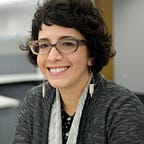Power to the people: What journalists can learn from community organizers
Organizers are trusted by their communities in a way that most journalists would envy. But organizing doesn’t immediately come to mind as part of a journalist’s job description—it might seem more like activism than reporting.
It doesn’t have to be.
In 2019 at Hearken’s Engagement Innovation Summit, journalists and organizers explained that community organizing can teach journalists how to build relationships with community members to make a difference—without crossing into activism.
The six-month project our Summit speakers worked on, called Stories of Atlantic City, illustrates how the principles of community organizing can create more diverse, nuanced coverage of a community.
Constituents, not consumers
The idea that journalism is about giving voice to the voiceless or empowerment is wrong, according to Mike Rispoli.
“Inherent in journalism is this idea that people don’t have voices, and that they don’t have power. Neither of which are true,” said Rispoli, director of the News Voices project for media technology advocacy organization Free Press.
“We believe that the public should be treated as constituents and not consumers of news,” Rispoli said.
Journalism instead is about sharing and building durable power with communities, he said. For this work, journalists can learn from community organizers, who are experts in building investment in a community to make things happen.
Community organizing requires several steps:
- Relationship building
- Bringing people together to understand existing attitudes and how they can work together to make things different
- Strategizing and visioning — trying to create a world that could be
- Taking action
- Learning and evaluation
Rispoli cautioned not to mistake organizing for activism. Instead, organizing is about understanding people’s needs, what world they want, collaborating with them to make it happen. And that, in order to shift journalism, we first have to shift the relationships that impact journalism.
In practice: Stories of Atlantic City
When people think about Atlantic City, they usually think of one thing: casinos, said Evan Sanchez.
Sanchez is the co-founder of Authentic City Partners, which has partnered on the Stories of Atlantic City project, which community members and local newsrooms created to provide nuanced news coverage that more accurately represents the diversity of Atlantic City.
“It feels like journalists kind of view community as a liability, but in reality it’s one of the key assets,” Sanchez said.
The secret sauce of the project, Sanchez said, was bringing both media partners and community partners together.
That process mapped to the community organizing process:
- Relationship building: They first reached out to community members and identified leaders who may be able to connect them to the community.
- Bringing people together: They held a free community mixer to attract community members who would be interested in sharing their stories or nominating people whose stories could be shared.
- Strategizing and visioning: Hearing community members’ ideas on how local news in Atlantic City could look different, they went to all local news organizations to ask them to participate in the Stories of Atlantic City project.
- Taking action: Sanchez and his collaborators knocked on doors and handed out flyers to find out what stories were not being told. Leaders in community would nominate the stories of people who journalists didn’t already know. Community members pitched 12 stories to the newsrooms, and “every single newsroom in that pitch meeting had never heard of these stories,” Rispoli said.
- Learning and evaluation: They then looked at what worked and what didn’t over the course of the six-month project, with plans to start on a longer timeframe next time.
Key takeaways
Trust takes time. It took four years to get the pieces in place for newsrooms and community members to work together on a six-month project.
“The amount of skepticism around this project was really, really strong because people had not seen their stories in local press for so long, they didn’t really understand it,” Sanchez said.
“I know, over time, that we’ll continue to break down more of that distrust, because really you can’t make change until you start to build trust.”
Be prepared for pushback from journalists. “There was definitely resistance to the idea that these stories would be sourced by community and pitched to them,” Sanchez said of the news organizations.
A couple tactics that helped were:
- making sure the newsrooms were compensated for their work out of the funding for the program (community organizers were also compensated)
- bringing them in at the earliest planning stages for the project
Look beyond grass-top leaders. Community leaders who are well-connected to newsrooms can be helpful but can sometimes hoard power, said James Thompson, then an organizer for Free Press. Reach into the leaders’ networks to get closer to the ground and think about the people who may not be leaders but know a lot about what is happening, such as baristas, hair stylists and cashiers.
- Journalists can use community mapping to identify the gaps and shortfalls in their existing relationships. And when they begin to have conversations with people, it should not only be as sources in a story but just to understand their needs and perspectives. Try setting up one-on-one conversations to build those relationships.
- “When you reach out to folks, it sends a message to them that you’re not only just focused on getting a quote from them but you’re spending time to understand what’s happening in that community,” Thompson said.
Resources:
Report: These Are the Stories of Atlantic City
